It is often said that 15,000L of water are needed to produce 1Kg of meat. This is an example of a shock statement used to make good headlines, but the calculations are too often misunderstood and misquoted. With more than 90% of water consumed by livestock being ‘green water’ (rainfall), scientists calculate that 1kg of beef would actually remove around 50L of fresh water.
The “Water footprint” is a popular concept…
This figure was first released in 2002, when the concept of “water footprint” was established, following the growing popularity of the ecological footprint indicators. Arjen Hoekstra, whilst working at the UNESCO-IHE Institute for Water Education, created the water footprint as a metric to measure the amount of water consumed and polluted to produce goods and services along their full supply chain. Interest in the water footprint grew rapidly after its introduction in academic literature. Today, the Water Footprint Network is working on the harmonisation and promotion of the “water footprint” concept.
…which hides a complex assessment
The water footprint is an indicator of freshwater use that looks not only at direct water use of a consumer or producer, but also at the indirect water use. It includes actually “three types of water sources”: the blue water (surface or groundwater sourced water consumption by the animals and the irrigation), the grey water (water used to depollute the effluents and recycle them) and the green water (rainfall).
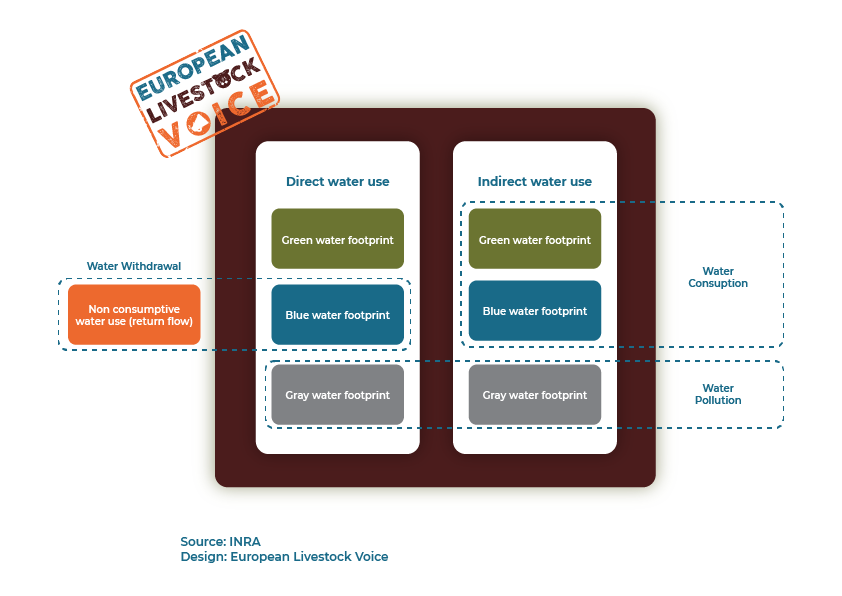
Livestock’s water footprint is made of 93% “green water”
It is essential to look at the structure of the water footprint. When considering livestock average water consumption, more than 90% is green water (rainfall) captured in the soil and evaporated by the plants and which returns to the water cycle. This would happen with or without farm animals.
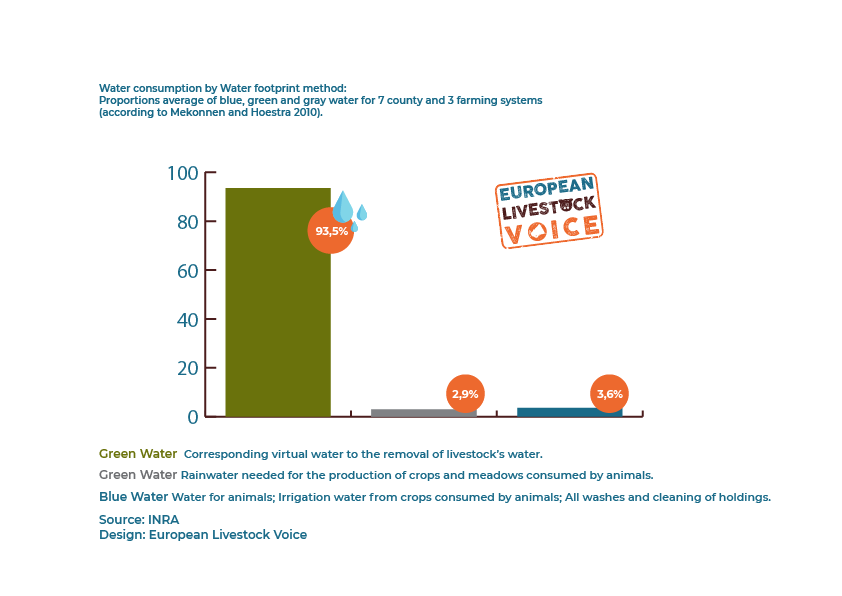
Green water which is part of these cycles, does not reflect the net consumption of water for animal production. Real water shortage may only be based on the blue water. If green water is taken out of the calculation, the scientific community considers that 550-700L are needed to produce 1 kg of beef (including grey and blue water). According to the French national research agency, INRA, 1kg of beef would actually remove around 50L of ‘real’ water (blue water) from the cycle.
Using the same approach, one can estimate that pork meat would require 450L, Chicken meat 300L, eggs 244L and milk 86L as indicated in the table.
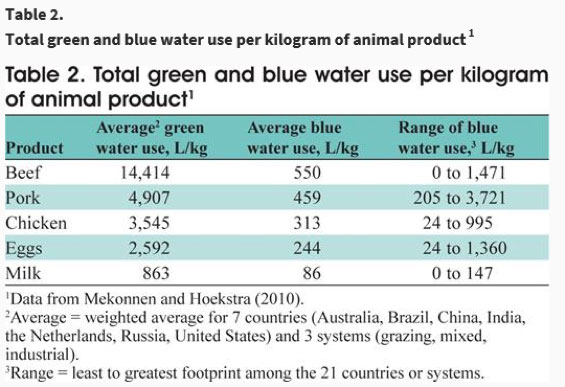
To quote the conclusion of the academic publication Animal Frontiers - “Water is a precious resource that must be conserved globally by all sectors of the economy, including agriculture and thus livestock farming. Tools such as the water footprint and LCA are available, but their interpretation by policy makers has to be refined.“ – conservation of water is necessary, but refinement of the data is required for true measurement of consumption.
Sources:
- https://www.theguardian.com/news/datablog/2013/jan/10/how-much-water-food-production-waste
- M.M Mekonnen et A.Y. Hoekstra, The green, blue and grey water footprint of farm animals and animal products, Value of Water Research Report Series no 48, UNESCO-IHE
- https://waterfootprint.org/en/about-us/aims-history
- Water footprint assessment manual
- http://www.inra.fr/Chercheurs-etudiants/Systemes-agricoles/Tous-les-dossiers/Fausse-viande-ou-vrai-elevage/Quelques-idees-fausses-sur-la-viande-et-l-elevage/(key)/0
- https://academic.oup.com/af/article/2/2/9/4638620
Agriculture accounts for 92% of the freshwater footprint of humanity and almost one third of this relates to animal products. This statement coming from a 2006 FAO report Livestock’s Long Shadow: Environmental Issues and Options, which is often reported, is very often also misunderstood, and indeed the report was revised at a later date. If you remove rainfall from the calculation, scientists estimate that livestock industries consume 8% of the global fresh water supply.
Its true meaning and the methodology used to calculate this figure remains unknown, this is why it is essential to first understand the concept of the “water footprint” to estimate the real impact of livestock. Livestock is using one third of all water resource when one include, green, grey and blue water (see previous question).
When considering average livestock water consumption, more than 90% is green water (rainfall) captured in the soil and evaporated by the plants and which returns to the water cycle. This would happen with or without farm animals.Considering blue and grey water, that could enter in competition with fresh water consumption, it is estimated that livestock industries consume 13% of the global water supply, with most of that water being used for intensive, feed-based production.
The underlying question behind this is actually the issue of a potential competition of use of water resource between livestock production and other human activities.
Fresh water is a scarce resource worldwide
The world contains an estimated 1,400 million cubic km of water. However “fresh water resources” are limited. Only 2.5% of all water resources are fresh water[ref]Food and Agriculture Organization of the United Nations (FAO). 2006. Livestock's Long Shadow: Environmental Issues and Options.[/ref] and only 0.003% of this vast amount, about 45 000 cubic km, could be used for drinking, hygiene, agriculture and industry (the rest being locked up in glaciers, permanent snow or in the atmosphere). Moreover, not all of this water is accessible because part of it flows into remote rivers during seasonal floods for instance. (FAO, 2017).
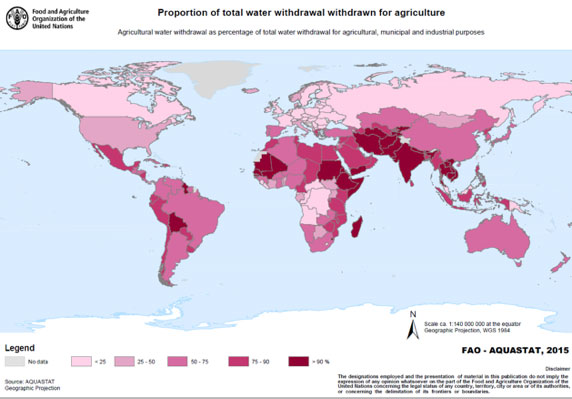
Global water demand is expected to increase greatly in the future, by 50% between 1995 and 2025 (United Nations Environment Programme, 2008), especially in developing countries, not only because of larger human populations, but also because of overall increases in industrial production and human affluence, which leads to greater consumption of energy, consumer goods, and food, especially animal products. This increase in domestic, industrial, and agricultural water use is expected to expand the areas affected by water scarcity[ref]Water use by livestock: A global perspective for a regional issue? Animal Frontiers, Volume 2, Issue 2, April 2012, Pages 9–16,[/ref].
Livestock production and water scarcity should be assessed at local level
There is not a global water shortage as such, but at individual countries and regions level the problem of water scarcity would need to be tackled. No evidence exists that the presence of livestock is related to the risk of water scarcity; for example, in France there is little overlap between regions with high livestock density and those with water-availability problems in summer, some of the latter being areas with irrigated crops.
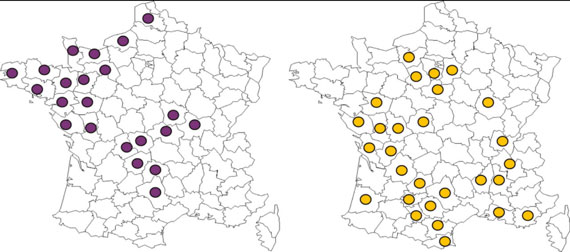
Global models need to be assessed with care
Global models are in the early stages of development and do not distinguish between developing and developed countries, or the production systems within them. In some regions, especially developing countries, animals are not used solely for food production but also to provide draught power, fibre and fertiliser for crops. The multiple dimensions of livestock production are not accounted for when considering the water consumption per kilo of product.
In addition, animals make use of crop by-products that would otherwise go to waste. Water usage for livestock production should be considered an integral part of agricultural water resource management, taking into account the type of production system (e.g. grain-fed or mixed crop-livestock) and scale (intensive or extensive), the species and breeds of livestock, and the social and cultural aspects of livestock farming in various countries.
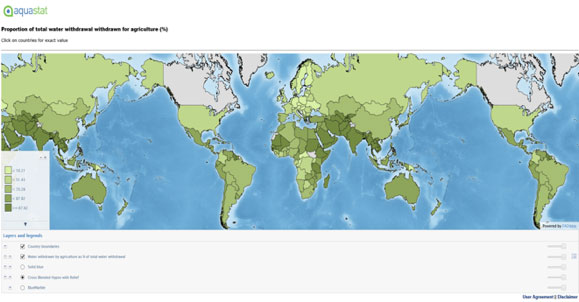
Improved farming practices could help to reduce livestock’s footprint
In Europe, limited margin exists when considering an improvement of direct water consumption by the livestock sector, as systems are already well optimised. For ruminants, total water intake is generally between 3.5 and 5.5 L/kg of dry matter intake. The greater the water content of feed, the less drinking water they require. For example, when early-stage fresh grass is fed, animals do not require drinking water. Increasing the proportion of fresh grass or silage in the diet thus decreases drinking water intake. (Source: https://academic.oup.com/af/article/2/2/9/4638620)
The main room for improvement to avoid local water shortage risks lies in the decrease of irrigated feeds. In this direction, a number of options exist ranging from the use of plants requiring less water or selected for their improved genetics to the enforcement of agronomic practices in fields by farmer feed producers.
Livestock can also have positive influences on water resources, for example, animal use of marshes damages biodiversity less than draining marshes to convert them to agriculture.
Sources:
- https://www.sciencedirect.com/science/article/pii/S2212371713000024
- Food and Agriculture Organization of the United Nations (FAO). 2006. Livestock’s Long Shadow: Environmental Issues and Options.
- https://www.researchgate.net/publication/49825039_Water_requirements_for_livestock_production_A_global_perspective
According to FAOSTAT 2016, global livestock production uses 1/3 of the world cereal production (210.5 million ha) and around 40% of arable land. However, the cereals used in animal feed are not the same quality of cereals used in human food.
The global livestock sector ingested an estimated 6.0 billion tonnes of feed (DM) in 2010. The three major feed materials were grass and leaves (46% or 2.7 million tonnes), followed by crop residues such as straws, stover (leaves and stalks) or sugar-cane tops (19% or 1.1 billion tonnes DM).
Total area of agricultural land currently used for livestock feed production at global level is 2.5 billion ha, which is around half of the global agricultural area
BUT
the largest share of this area is made up of grasslands, with almost 2 billion ha.
The production of cereals for monogastrics (e.g. pigs and poultry) occupies 138 million ha, or 20% of the global cereal-growing area. In addition, the global livestock sector uses about 66 million ha to produce cereal and legume silage and fodder beets. Using the allocation method based on mass and value of co-products, about 131 million ha can be attributed to the sector for oil seed cakes and 126 million ha for crop residues. Total arable land used to feed livestock reaches about 560 million ha, or about 40% of the global arable land.
For more information: Resource Efficiency Champions: Co-Products, an Essential Part of Animal Nutrition
Livestock feed is often presented as being in competition with human food. But according to FAO, 86% of livestock feed is not suitable for human consumption.
It is often reported that 6-20kg of cereals are required to produce 1kg of beef. These figures certainly do not apply in the case of Europe and the calculation is incorrect even at a global level!
Taking the EU ruminant production system as an example, this is based on grazing and mixed systems. Grasslands provide a significant role in fodder used to feed the livestock, converting grass into highly nutritious food. Also, concentrated feed given to livestock are composed of crop residues and by-products of cereals (from milling starch factory, distillery), protein crops (pea co-products), oilseed (oilcake rapeseed, sunflower), fruit (pulp citrus), vegetables and tubers (pulp beet, potato) as well as milk (whey from cheese factories).
Therefore, the ration of human-edible food in the ruminant sector grazing and mixed systems is very low. At global level, human-edible feed materials represents about 14% of the global livestock feed ration.
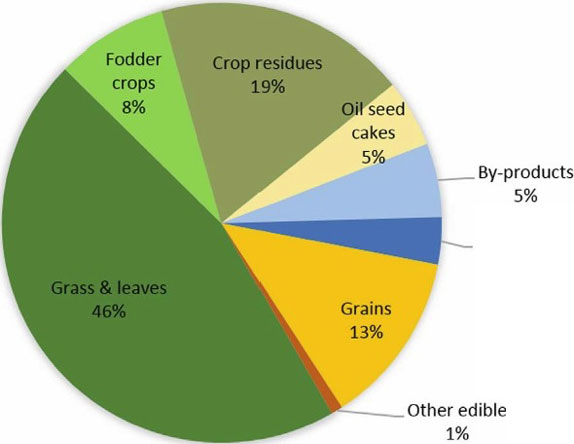
A recent study carried out by some researchers of the Friedman School of Nutrition Science and Policy available in Elementa magazine - Science of the Anthropocene, has showed how comparing ten different diets, the more vegan oriented shows a worse and less differentiated use of the “resource soil”.
Ten very different diets representing ten ways to influence the environment, ten ways - perhaps - to influence our and natural life, so also world biodiversity and somehow the cultural heritage such as the landscape. Among the ten diets, those excluding animal origin food, generally believed more “virtuous”, have revealed to be less efficient in land managing as focusing only on arable and comfortable land exploiting.
According to the results, land use connected to vegan diet would be able to feed fewer people than a land use based on omnivores diet. So, it means that completely and suddenly eliminating animal-based products may not be the most sustainable option in the long term for mankind.
A vegan diet may not be the best choice in function of the human population, protein needs and world soil resources management. Indeed in a paradox scenario made of 100% vegans, we would need more arable lands, as ingredients of the vegan diet are produced with a very low efficiency i.e. in grazing lands.
Not all agricultural lands are comparable in terms of theoretic productivity: some of them, for example, give their best with cereals, but they are inefficient for fruit and vegetable productions (i.e. clayey soils poor in water resources ), other lands, on the other side, fit only for pastures as vegetable cultures would represent a too high energetic factor choice (stones density, soil depth, slope incidence, etc).
The need for importing soy for animal feed is related to a specific nutritional need. An EU initiative to boost local plant protein production in order to increase our self-sufficiency of protein-rich is welcomed by the European livestock sector, however the expectation is that Europe will remain reliant on significant amounts of soy imports for the foreseeable future.
The revised EU Feed Protein Balance Sheet published by the European Commission in May 2019 shows that in terms of overall protein needs Europe is 79% self-sufficient. However, in the category of ‘high-pro’ feed materials (30%-50% protein) Europe only has 29% self-sufficiency and therefore relies strongly on imports, which are for a large part filled by soybean meal.
The EU annually imports approximately 30 million tonnes of soybean meal equivalent. This figure has been fairly stable over the past 30 years. Soybean products have become the principal source of protein-rich feed materials for the feed industry worldwide, setting the benchmark for all other vegetable protein sources. Soybean crops score uniquely high on the key nutritional characteristics of what makes a high-quality protein source for feed manufacturing for many types of farm animals: amino acid profile, protein concentration, nutrient density, digestibility and palatability. But also their affordability, consistency and all-round availability, including the possibility for using price hedging tools, make it the first choice for both animal nutritionists and feed buyers.
The EU initiative to boost local plant protein production is an attempt to increase the self-sufficiency of the protein-rich feed materials that the EU currently needs to import. This is certainly a welcome initiative for livestock farming in Europe, particularly from an agronomic rotation perspective. Nevertheless, the expectation is that Europe will remain reliant on significant amounts of soy imports, even in the long term.
Animal medicines do not pose a major risk to the environment when they are used appropriately and in accordance with the product instructions for use.
The European Medicines Agency sets out guidelines for assessing toxicological risk to human health and groundwater communities from veterinary pharmaceuticals in groundwater. This means that, when used appropriately and in accordance with the manufacturers’ label and instructions, animal medicines do not pose a major risk to the environment.
The EU regulatory process for animal medicines licencing is designed to assess environmental safety prior to medicine approval. A marketing authorisation application for a veterinary medicine must include data addressing the safety for the user, the animal, the consumer and the environment. As a part of the safety dossier, a veterinary medicine needs an environmental risk assessment (ERA) before it can be approved. This requirement has been in the veterinary medicines legislation since 1992 .
For any animal medicines where the risks to the environment are higher than the benefits of the product, it will be denied an authorisation for use.
On the contrary, according to FAO statistics enteric fermentation coming from the EU livestock sector has almost halved its impact in the period 1990-2014.
There has been a 51% drop in emissions from livestock as shown by the FAO statistics, largely due to the shift to a more specialised agricultural livestock system, with still relevant large margin for improvement.
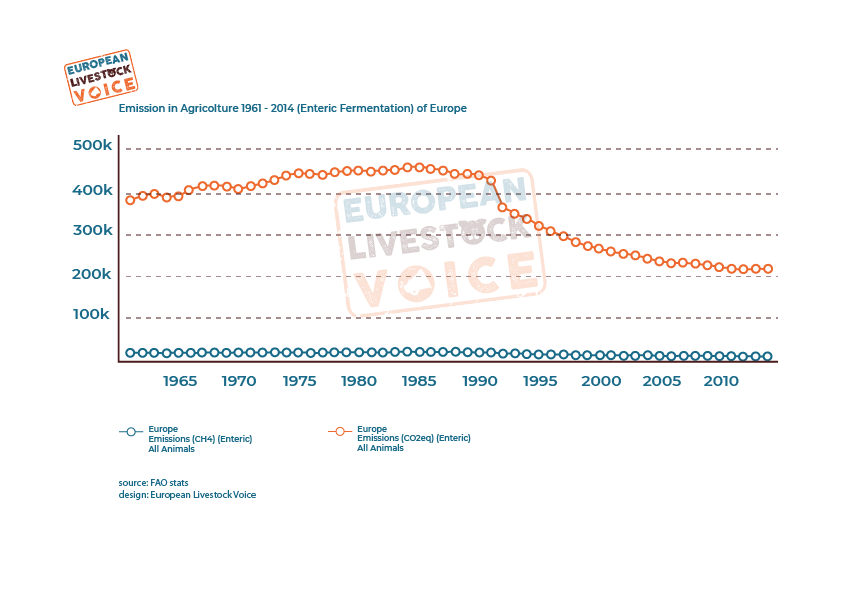
According to the latest European Environment Agency figures, just under 6% of the EU emissions come from livestock GHG emissions. Total agriculture accounts for 9.58% and non-agricultural sectors account for 90.19%. This includes transport, heating, buildings, etc., it doesn’t include land use and land use change.
Thanks to new precision agriculture and advanced agronomic practices the European livestock sector will continue to be able to provide more sustainable and affordable animal-sourced food products to European consumers.
And the fundamental role of livestock in the circularity of the agriculture sector should not be forgotten, for instance in manure use (also as biogas digestate) for soil fertility and carbon storage and in the consequential avoided emissions to produce agrochemicals and other products derived from oil (i.e. products alternative to leather).
Sources:
- https://ec.europa.eu/eurostat/statistics-explained/pdfscache/16817.pdf
- http://www.fao.org/faostat/en/#compare
There are indeed a number of ways through improved animal management to reduce emissions from livestock according to the FAO.
One simple way to reduce emissions - something that is often forgotten in public debates - is simply to limit and reduce food waste. According to the FAO, 40-50% of fruit and vegetables are wasted at source, while for meat/dairy the FAO estimates losses at 20%. Food waste accounts for 8% of global emissions. In industrialised countries more than 40% of all food losses happen at retail and consumer levels, so promoting less food waste can also contribute to further emission reductions.
The emissions intensity of methane and the potential to mitigate all associated emissions, varies greatly across regions and also between production systems. The FAO estimates that wide gap in emissions intensity for ruminant products is due to different agro-ecological conditions, farming practices and supply chain management. It is within this variability that many mitigation options can be found, and that with the right incentives, can be exploited to close the gap[ref]http://www.fao.org/in-action/enteric-methane/background/reducing-emission-intensity/en/[/ref].
Within the farm, solutions also exist to reduce emissions and many measures have already been taken by farmers over the past two decades. A new report from FAOestimates that partially reducing the emission intensity gap within existing production systems through improved management could cut emissions by about 30%.
Amongst the opportunities identified to reduce emissions, further research is needed to fully measure impact on productivity and cost-efficiency. These opportunities can be classified into the following broad areas:
- Feed and Nutrition: The animal feed sourcing and production stage represents the lion share of the emissions associated with pig, poultry and fish production. Significant work has been put into building the methodology (PEFCR Feed for Food-Producing Animals) and database (Global Feed LCA Institute) to allow feed manufacturers to take the reduction of the environmental footprint into account in the feed formulation process upon demand of downstream chain partners. Over the course of the years, innovation in animal nutrition science has delivered feed additives solutions such as amino acids, enzymes and probiotics which have enabled more efficient use of available feed materials, reducing impacts on GHG emissions, acidification and eutrophication. For example, phytase (the most widely used feed enzyme in the world) has allowed for an increased digestibility by animals of the available phosphorous in feed materials, leading to a reduced need for feed intake. The positive effects of feed additives in the reduction the environmental footprint of animal farming have been demonstrated also through Life Cycle Analysis in a specific project called Specialty Feed Ingredients Sustainability Project (SFIS)2.
For cattle specifically, improving feed quality can be achieved through improved grassland management, improved pasture species, forage mix and greater use of locally available supplements. Matching ruminant production to underlying grazing resources, ration balancing, undertaking adequate feed preparation and preservation will improve nutrient uptake, ruminant productivity and fertility[1]. A lot of research efforts are being put into reducing enteric emissions from ruminants, for example by adapting the forage composition, adapting the kind of feed materials used and the inclusion of feed additives.
- Animal Health and Husbandry: Increasing the biological efficiency of the ruminant by improving the reproduction rates and extending the reproductive life of the animal is key to reducing methane emissions, but this can be constrained by disease, and especially, production-limiting endemic disease. Production-limiting diseases have a number of negative outcomes, including: death or culling of previously healthy animals; reduced live-weight gain; reduced milk yield and quality; reduced fertility; abortion and/or increased waste in the system. So, reducing the incidence of endemic disease will generally result in healthier animals that are more productive[ref]http://www.fao.org/in-action/enteric-methane/win-win-opportunities/en/[/ref].
- Advanced monitoring techniques: Opportunities in technology and the Internet of Things, Big data, block chain, drones, and remote sensing for free ranging livestock may offer opportunities for entirely new ways of monitoring GHG emissions and removals at an unprecedented level of detail and perhaps with reduced uncertainty and increasing precision. Artificial intelligence and increasing computational power can allow future systems to process huge amounts of data and provide overviews, trend lines and breakdowns as needed. These developments may open up for animal-level monitoring and optimisation. Uptake will naturally require adequate funding and a clear benefit in terms of investment.
- Animal Breeding: Modern Animal Breeding programs are managing to combine many different goals in a responsible and a balanced way. One of them is the reduction of emissions from ruminants and monogastric farmed species. This can be achieved directly and indirectly. We can reduce methane emissions by selecting animals that produce less CH4 and live longer (improved longevity). We can also make a selection for a better use of the feed, whatever the source, to reduce ammonia excretion in ruminant and monogastric. Longevity traits that are linked to animal welfare, like the vitality and highest survival of the animals and their off-spring help to reduce emissions and carbon footprint of animal production. Traits linked to animal health; like animal disease resistance and robustness lead to lower emissions from livestock.